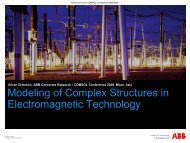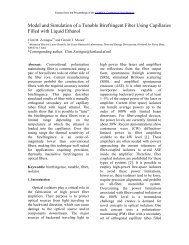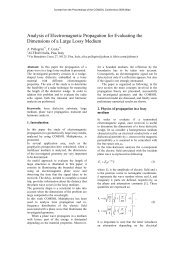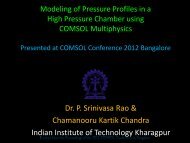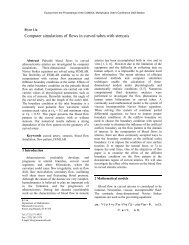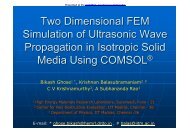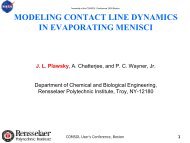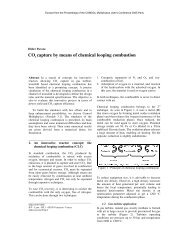Numerical Modeling of Dielectrophoretic Forces ... - COMSOL.com
Numerical Modeling of Dielectrophoretic Forces ... - COMSOL.com
Numerical Modeling of Dielectrophoretic Forces ... - COMSOL.com
- No tags were found...
Create successful ePaper yourself
Turn your PDF publications into a flip-book with our unique Google optimized e-Paper software.
Excerpt from the Proceedings <strong>of</strong> the <strong>COMSOL</strong> Users Conference 2007 Grenoble<strong>Numerical</strong> <strong>Modeling</strong> <strong>of</strong> <strong>Dielectrophoretic</strong> <strong>Forces</strong> Acting uponBiological Cells in Silicon Lab-On-Chip DevicesS. Burgarella *,1 , M. Bianchessi 1 and M. De Fazio 11 STMicroelectronics, Advanced System Technology, R&I e-Health*Corresponding author: STMicroelectronics, Centro Dir. Colleoni, Pal. Dialettica, Via Cardano 1, 20041Agrate Brianza (MI), Italy, sarah.burgarella@st.<strong>com</strong>Abstract: Dielectrophoresis (DEP) is apromising method for the automated separation<strong>of</strong> biological cells in a miniaturized format. Thistechnology allows cells to be manipulatedelectronically while suspended in a micr<strong>of</strong>luidicchannel embedded in a silicon lab-on-chip.Several dielectrophoretic configurations havebeen designed and fabricated using microelectro-mechanical-systems(MEMS)technology. The finite element s<strong>of</strong>tware<strong>COMSOL</strong> Multiphysics has been used toperform the numerical simulation <strong>of</strong> thedielectrophoretic forces acting on the particles.The functioning <strong>of</strong> the devices has beendemonstrated with both polystyrene beads andhuman blood cells; the experimental resultsagree to those from modeling.Keywords: dielectrophoresis, cell sorting, labon-chip,miniaturization, micr<strong>of</strong>luidics, MEMS.1. IntroductionThe ability to manipulate particlessuspended in a liquid, without physical contact,has significant potential for applications inminiaturized biotechnological platforms such as<strong>com</strong>pact lab-on-chip devices [1]. The currentmethodologies for cell separation are magneticactivatedcell sorting (MACS) and fluorescenceactivatedcell sorting (FACS), but their reportedperformances in the microscale lag behind those<strong>of</strong> their macroscopic counterparts [2].Dielectrophoresis (DEP) is a promising newmethod for the manipulation and the separation<strong>of</strong> biological cells via high-gradient quasi-staticelectric fields [3]. The non-uniform electricfields are generated by microelectrodes patternedon the silicon substrates <strong>of</strong> micr<strong>of</strong>luidic channelsusing fabrication techniques borrowed frommicro-electro-mechanical-systems (MEMS)technology. Several electrodes configurationshave been designed and fabricated in order toachieve different functions on the chip such astrapping selected microparticles at a barelectrode array filter and collecting selectedmicroparticles at the centre <strong>of</strong> a multispiral array.<strong>Numerical</strong> modeling has been performed inorder to simulate the electric field distributiongenerated by the electrode configurations and toquantify the consequent dielectrophoretic forcesacting on the suspended particles. The finiteelement s<strong>of</strong>tware <strong>COMSOL</strong> Multiphysics hasbeen used to solve the quasi-static electric field,neglecting the magnetic field due to the timevarying electric field, and to determine the pico-Newton DEP forces acting at the microscale.<strong>Forces</strong> are calculated under the point dipoleassumption, for both particles collection instanding-wave excitation and induced motion intravelling-wave configuration. <strong>Modeling</strong>strategies are generalizable to arbitrary electrodedesign as well as to condition where DEP forcemay not act alone to cause particle motion.The functioning <strong>of</strong> the electrodeconfigurations has been demonstrated with bothpolystyrene beads and human blood cells. Theexperimental results and those from modelingare found to be in agreement.( )F r2. Governing Equations2.1 <strong>Dielectrophoretic</strong> ForceDielectrophoresis is a phenomenon in which aspatially non-uniform electric field exerts a netforce on the field-induced dipole <strong>of</strong> an unchargedparticle. Under the action <strong>of</strong> an external ACelectric field exhibiting a sinusoidal temporalvariation with angular frequency ω, the net timeaverageddielectrophoretic force exerted on theparticle at the spatial position r is given by (1):⎡Re3= 2πεmR⎢⎢Im⎣( F )CM∇ E +2rms2 2 2( FCM )( Ex0∇ ϕx + Ey0∇ ϕy + Ez0∇ϕz)⎤⎥⎥⎦(1)where ε m is the permittivity <strong>of</strong> the suspendingmedium, R is the radius <strong>of</strong> the spherical particle,F CM is the Clausius-Mosotti factor, E x0 , E y0 , E z0are the magnitudes and φ x , φ y , φ z are the phases<strong>of</strong> each field <strong>com</strong>ponent and E rms is the root
Excerpt from the Proceedings <strong>of</strong> the <strong>COMSOL</strong> Users Conference 2007 Grenoblemean square value <strong>of</strong> the electric field strength.The translational force acting on a polarizedparticle has two contributions, given by (2) and(3), respectively:3( ) = 2πεRe( )F r R F E2DEPmCM rms∇ (2)( ) = 2πε ( )( )3 Im2 ∇ ϕ + 2 ∇ ϕ + 2ϕm CM x0 x y0 y z0FTWDr R F E E Ez∇ (3)The DEP force term in (2) relates to the in-phase<strong>com</strong>ponent (αRe(F CM )) <strong>of</strong> the induced dipolemoment and the field magnitude non-uniformityfactor2∇E rms. The TWD (Travelling WaveDielectrophoresis) force term in (3) relates to theout-<strong>of</strong>-phase <strong>com</strong>ponent (αIm(FCM)) <strong>of</strong> theinduced dipole moment and the field phase nonuniformityfactors ∇ ϕ .i2.2 Clausius-Mosotti FactorAssuming that both the suspending mediumand the particle are homogeneous dielectricswith ohmic electrical conductivities σ m and σ p ,the <strong>com</strong>plex, frequency-dependent Clausius-Mosotti factor is calculated accordingly to (6),from the <strong>com</strong>plex permittivities <strong>of</strong> the medium(ε * m ) and <strong>of</strong> the particle (ε * p), respectivelydefined by (4) and (5):∗εmjσm= ε − ,mFCMω∗εpjσp= ε − (4), (5)p∗ ∗ε − εp m= . (6)∗∗ε + 2εpmEucariotic cells, containing nucleus suspendedin a semi-fluid medium called the cytosol, areenclosed by outer membranes. They can bemodelled as layered spherical particles using aneffective <strong>com</strong>plex permittivity. For the particle<strong>of</strong> radius R, with a single outer shell <strong>of</strong>thickness d , the effective <strong>com</strong>plex permittivity*ε p,eff can be described as in (7):∗ε∗= εR( )R dR( )p, eff s3ω3∗ ∗⎡ ⎛ ε − ε ⎞⎤int s⎢+ 2⎜∗∗ ⎟⎥− ε + 2εints⎢⎝ ⎠⎥∗ ∗⎢ ⎛ ε − ε ⎞ ⎥int s⎢− ⎜ ∗∗ ⎟ ⎥⎣ R − d ⎝ε+ 2εints ⎠ ⎦(7)Tab. 1: Dielectric properties <strong>of</strong> human B-lymphocytesPropertyValueRadius8 µmMembrane thickness8 nmRelative permittivity (interior) 50Conductivity (interior) 0.45 S/mRelative permittivity (membrane) 3Conductivity (membrane) 3 µS/mwhere ε * s and ε * int are the <strong>com</strong>plex permittivity<strong>of</strong> the shell and that <strong>of</strong> the cell interior,respectively.<strong>Numerical</strong> models have been realized inMatlab (R14, The Mathworks) in order to predictthe frequency dependance <strong>of</strong> the Clausius-Mosotti factor for both polystyrene beads andhuman B-lymphocytes, suspended indemineralized water or in isotonic medium. Thehomogeneous particle model has been used tocalculate the factor F CM for polystyrene beads,according to (4), (5) and (6); the layeredspherical particle model has been applied for thecalculation <strong>of</strong> factor F CM for B-lymphocytes,according to (4), (6) and (7). Permittivity andconductivity <strong>of</strong> the polystyrene beads wereassumed to be 2.5ε 0 ad 8 x 10 -4 S/m, where ε 0 isthe permittivity <strong>of</strong> free space. Dielectricproperties <strong>of</strong> human white blood cells have beeninvestigated in literature [4] [5] and their valuesare reported in Tab. 1.3. <strong>Numerical</strong> Model3.1 Standing Wave ConfigurationFig. 1 shows the real <strong>com</strong>ponent <strong>of</strong> the factorF CM as a function <strong>of</strong> the frequency <strong>of</strong> the appliedelectric field, for both human B-lymphocytes andpolystyrene beads suspended in isotonic PBS(Phosphate-Buffered Saline) solution(permittivity <strong>of</strong> 80ε 0 and conductivity <strong>of</strong> 0.13S/m). The DEP force directs the particle towardsthe strong or the weak field regions, dependingupon whether Re(F CM ) is positive or negative. Atthe crossover frequency Re(F CM )=0 and therebyno dielectrophoretic force is acting on theparticle. At higher frequency, Re(F CM )>0 for B-lymphocytes with a maximum value <strong>of</strong> 0.4 at 10MHz: this frequency allows the cells to betrapped at the electrodes, while the beads aredirected away from these regions <strong>of</strong> highgradientelectric field because the real<strong>com</strong>ponent <strong>of</strong> their Clausius-Mosotti factor isnegative, with a value <strong>of</strong> –0.5 at 10 MHz.
Excerpt from the Proceedings <strong>of</strong> the <strong>COMSOL</strong> Users Conference 2007 GrenobleReal <strong>com</strong>ponent <strong>of</strong> Clausius-Mosotti factor10.80.60.40.20-0.2-0.4-0.6-0.8-1Re[F cm ] for human B-lymphocytesRe[F cm ] for polystyrene beads10 1 10 2 10 3 10 4 10 5 10 6 10 7 10 8 10 9 10 10Frequency (Hz)Figure 1. Real <strong>com</strong>ponent <strong>of</strong> the Clausius-Mosottifactor for both human B-lymphocytes and polystyrenebeads suspended in PBS solution.On the bottom <strong>of</strong> the dielectrophoreticmicrochannel an interdigitated bar electrodearray is patterned, consisting <strong>of</strong> 8 electrodes,each 20 µm wide with a 20 µm gap. Electrodesare 1 mm long and the channel is 40 µm height.Because the electrodes are long relative to theirwidth, the problem can be considered twodimensionaland the model describes the crosssection <strong>of</strong> the channel.The single-harmonic electric field used instanding wave configuration is generatedapplying a sinusoidal voltage signal to theelectrodes and the phase <strong>of</strong> each field <strong>com</strong>ponentis either the same as, or exactly 180° from, theapplied voltage at every point. Thus the phasenon-uniformity factors are zero at every pointexcept where phase transitions occur. Fieldcontinuity requires the field intensity to be zeroat such transition points, so that the TWD<strong>com</strong>ponent <strong>of</strong> the dielectrophoretic force is zeroeverywhere for a single phase excitation [6].The finite element s<strong>of</strong>tware package<strong>COMSOL</strong> Multiphysics was used to solve forthe quasi-static electric field and for equation (2).The simulation models the electric field acting inthe microchannel and the pico-Newtondielectrophoretic force acting on both thepolystyrene beads and the human B-lymphocytes, once known the position r <strong>of</strong> theparticle in the chamber. This knowledge can bevery useful in designing and operating adielectrophoretic filter to sort and select particlesentering the micr<strong>of</strong>luidic device for furtheranalysis. The 10V peak-peak, 10 MHz sine wavevoltage applied across alternating electrodesestablishes a non-uniform electric field.Electrodes are assumed isopotential so theirthickness is neglected. For the boundariesrepresenting the electrode gaps, imposing aninsulation condition will arise a mathematicalsingularity due to the <strong>com</strong>peting Dirichlet andNeumann conditions. To over<strong>com</strong>e this problem,the Neumann condition inside the gaps waschanged by a Dirichlet condition, imposing thevoltage to linearly vary between the valuesassumed at two subsequent electrodes. At allother boundaries the model assumes that thechannel is electrically insulated. The model usesa double refined mesh and solves for 3857degrees <strong>of</strong> freedom.Fig. 2 shows the calculation results for boththe magnitude <strong>of</strong> the electric field and thedielectrophoretic force acting on B-lymphocytes.Voltage boundary conditions are shown as well.The field strength is represented by the colorscale surface, while the contour lines indicate theDEP force. The force maxima locate close to theelectrode edge and in its nearby gap, decreasingrapidly with height. Fig. 3 <strong>com</strong>pares thesimulation results for both the magnitude <strong>of</strong> theelectric field and the dielectrophoretic forceacting on B-lymphocytes and polystyrene beads,focusing on the two central electrodes for bettervisualization purpose. The normalized vectorsrepresent the DEP force, and point towards theelectrodes for lymphocytes, away from them forthe beads. The field strength is represented bythe colour scale surface, while the DEP forceintensity is represented by the contour lines plot.At the height <strong>of</strong> 15 µm above the bottom <strong>of</strong> thechannel, dimension which is <strong>com</strong>parable to thediameter <strong>of</strong> the suspended particles, the DEPforce intensity is about 4 nN for both B-lymphocytes and polystyrene beads, indicating astrong attraction or repulsion.Figure 2. Electric field and dielectrophoretic forceacting on B-lymphocytes; voltage boundaryconditions.
Excerpt from the Proceedings <strong>of</strong> the <strong>COMSOL</strong> Users Conference 2007 GrenobleImaginary <strong>com</strong>ponent <strong>of</strong> Clausius-Mosotti factor for polystyrene beadsIm - σ m= 10 -5 (S/m)0.4Im - σ m= 10 -4 (S/m)Im - σ m= 10 -3 (S/m)Im - σ m= 10 -2 (S/m)0.2Im - σ m= 10 -1 (S/m)Im - σ m= 1 (S/m)Im[Clausius-Mosotti]0-0.2-0.4-0.610 1 10 2 10 3 10 4 10 5 10 6 10 7 10 8 10 9 10 10Frequency (Hz)Figure 4. Imaginary <strong>com</strong>ponent <strong>of</strong> the Clausius-Mosotti factor for polystyrene beads suspended indemineralized water.Figure 3. Electric field and dielectrophoretic forceacting on B-lymphocytes (top) and polystyrene beads(bottom); detail <strong>of</strong> the two central electrodes.3.2 Travelling Wave ConfigurationIn order to operate in travelling waveconfiguration and to move the beads in a specificdirection, particles must not be attracted towardsthe electrodes and therefore the real <strong>com</strong>ponent<strong>of</strong> the F CM factor must be negative, with anabsolute value nearly zero in order not to have atoo strong repulsion from the electrodes region.The imaginary <strong>com</strong>ponent <strong>of</strong> the F CM factor hasto be as high as possible in its absolute value.Fig. 4 shows the frequency dependence <strong>of</strong> theF CM factor for polystyrene beads suspended indemineralized water. The suspending medium ischaracterized by permittivity <strong>of</strong> 80ε 0 and variableconductivity between 10 -5 S/m and 1 S/m. At 200kHz, the requirements on the F CM are satisfiedfor different degrees <strong>of</strong> medium mineralization,with electrical conductivity ranging from 10 -5 to10 -3 S/m. The values for the real and imaginary<strong>com</strong>ponent <strong>of</strong> the F CM are Re(F CM )= –0.2 andIm(F CM )= –0.35.Electrodes for travelling wave DEP have beenpatterned in a multispiral array: particles arelevitated and carried towards the centre <strong>of</strong> theconfiguration. The spiral array is <strong>com</strong>posed <strong>of</strong> 5<strong>com</strong>plete turns <strong>of</strong> four parallel spiral elements 20µm in width and spacing. Because <strong>of</strong> the radialsymmetry <strong>of</strong> the configuration, the problem canbe considered two-dimensional and thenumerical model can be reduced to a singleradial section. Subsequent electrodes are excitedwith 90 degrees phase shifted sine waves, at 200kHz frequency and with a 5V peak-peakamplitude. Electrodes are assumed isopotential.At the boundaries, representing the electrodegaps, the Neumann condition was changed by aDirichlet condition, imposing the voltage tolinearly vary between the values assumed at twosubsequent electrodes. All other boundaries areelectrically insulated. On the radial section, thehorizontal <strong>com</strong>ponent <strong>of</strong> the travelling wavedielectrophoretic force is defined by (8):3 ⎛ 2∂ϕ∂ϕx 2 y ⎞F = 2πεR Im( F ) E ETWD xm CM ⎜ +x 0 y 0 ⎟ (8)⎝ ∂x∂x⎠The calculation for the horizontal <strong>com</strong>ponent <strong>of</strong>the dielectrophoretic force can be simplifiedconsidering only the variation <strong>of</strong> the phasesalong the horizontal direction, as in (9) and (10):ϕϕxy( r)( r)2πx≅ →λ2πx≅ →λ∂ϕ2πx≅∂xλ∂ϕy2π≅∂xλ(9)(10)where λ is the length <strong>of</strong> the travelling field, thatis the periodic distance between electrodes withthe same phase and it is assumed to be <strong>of</strong> 160µm in this electrode configuration. The
Excerpt from the Proceedings <strong>of</strong> the <strong>COMSOL</strong> Users Conference 2007 Grenoblehorizontal <strong>com</strong>ponent <strong>of</strong> the dielectrophoreticforce assumes therefore the expression in (11):3 ⎛ 2 22π⎞F = 2πεR Im( F )TWD m CM( E + Ex 0 y 0)x⎜⎟⎝ λ ⎠ (11)Fig. 5 shows the calculation results for theforce given by (11) above the two centralelectrodes <strong>of</strong> the considered microchannel’ssection, for better visualization purpose. Themagnitude <strong>of</strong> the electric field is represented bythe colour scale surface, while the TWD forceintensity is represented by the contour line plotand by the arrows <strong>of</strong> proportional length. Theforce maxima locate close to the electrode edgeand in its nearby gap, decreasing rapidly withheight. At 15 µm, the intensity is about 50 pN.Fig. 6 shows plot <strong>of</strong> the intensity <strong>of</strong> the TWDforce at different heights in the channel, takenover a gap axis, both in a linear and in alogarithmic scale.Figure 5. Electric field and TWD force acting onpolystyrene beads.4. Experimental Results4.1 Cells and Beads SuspensionHuman EBV-PBL (Peripheral BloodLymphocytes immortalized by Epstein BarrVirus) were suspended in Dulbecco’s isotonicPBS (Ca 2+ /Mg 2+ free Phosphate-BufferedSaline), to a final cell density <strong>of</strong> 2 x 10 6 cells/ml.Polystyrene beads with density 1.602 g/cm 3 ,packaged as 10% solids in water, were purchasedfrom Sigma Aldrich. The size <strong>of</strong> the beads was15 µm in diameter,
Excerpt from the Proceedings <strong>of</strong> the <strong>COMSOL</strong> Users Conference 2007 Grenoble4.3 Electrical ExcitationStanding wave configuration experiment isshown in Fig. 7. Without an applied voltage, B-lymphocytes and polystyrene beads wererandomly distributed in the channel. A 10 MHzsine wave <strong>of</strong> 10 V peak-peak, obtained with anAgilent 33250 function generator, was applied tothe electrode array in order to separate the cellsfrom the beads suspended in the same PBSsolution. At this frequency excitation the beadswere directed away from the electrodes bynegative DEP forces, while B-lymphocytesbegan to accumulate onto the electrodes, drivenby positive DEP forces and gradually formingpearl-chains. Different subsequent electrodespairs were turned on and <strong>of</strong>f, allowing cells to becollected in a specific region and then moved ineither direction.Travelling wave configuration experiment isshown in Fig. 8. Without an applied voltage,polystyrene beads were randomly distributedover the spiral electrodes array. With aquadrature, 200 kHz, 5 V peak-peak sine waveelectric excitation, particles were levitated andcarried towards the centre <strong>of</strong> the spiral by theTWD forces. The voltage application lasted forabout 40 seconds, and the pictures in Fig. 8 aretaken at 10 seconds intervals.Particle motion was observed using a standardbrightfield microscope, with a custom videocamera mounted on it. The camera was based onST VV5501 VGA CMOS image sensor, inconjunction with its evaluation kit for exposureparameters setting and PC connection.5. ConclusionsThe functioning <strong>of</strong> the silicon lab-on-chipdevices for cell sorting by dielectrophoresis hasbeen demonstrated with both polystyrene beadsand human blood cells, in conjunction with afinite element modeling. The experimental andtheoretical results are found to be in closeagreement. The <strong>com</strong>bination <strong>of</strong> modeling andexperiments has given insight into the nature <strong>of</strong>DEP trapping for various biological applications.By simple adjustment <strong>of</strong> the electrical fieldparameters, other cell subpopulations <strong>of</strong>particular interest, such as staminal or tumoralcells, could be separated, isolated and analyzed,acting on the signal frequency.Figure 7. Sorting <strong>of</strong> B-lymphocytes and polystyrenebeads by DEP forces.Figure 8. Progressive collection <strong>of</strong> polystyrene beadsby TWD force.Dielectrophoresis <strong>of</strong>fers the potential forautomated cell sorting in a miniaturized format,as it represents the front-end sample preparationfor interfacing clinical sample to the micr<strong>of</strong>luidicdomain <strong>of</strong> silicon lab-on-chip devices.6. References1. Huang Y et al., “Electric manipulation <strong>of</strong> bioparticles andmacromolecules on micr<strong>of</strong>abricated electrodes”, Anal Chem.,73, 1549-59, 2001.2. Hu X et al., “Marker-specific sorting <strong>of</strong> rare cells usingdielectrophoresis”, Proc Natl Acad Sci USA., 102-44, 15757-61, 2005.3. Fu LM et al., “Manipulation <strong>of</strong> microparticles using newmodes <strong>of</strong> traveling-wave-dielectrophoretic forces: numericalsimulation and experiments”, IEEE/ASME Transaction onMechatronics, 9-2, 377-83, 2004.4. Yang J et al., “Dielectric properties <strong>of</strong> human leukocytesubpopulations determined by electrorotation as a cellseparation criterion”, Biophysical Journal, 76, 3307-3314,1999.5. Yang J, et al., “Differential analysis <strong>of</strong> human leukocytesby dielectrophoretic field-flow-fractionation”, BiophysicalJournal, 78, 2680-2689, 2000.6. Jones TB., “Basic theory <strong>of</strong> dielectrophoresis andelectrorotation”, Engineering in Medicine and BiologyMagazine, IEEE, 22-6, 33-42, 2003.


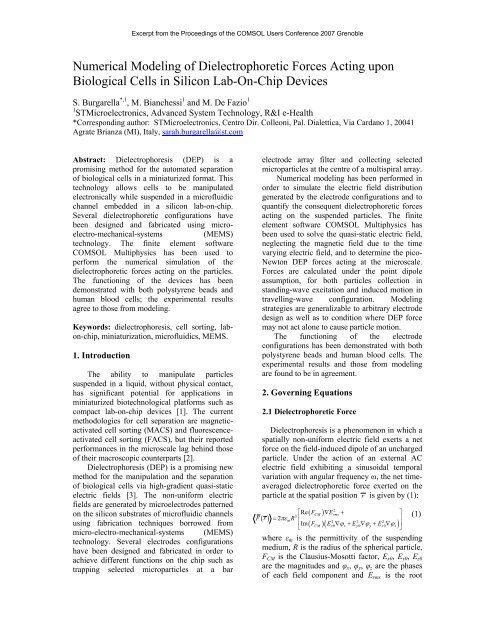
![[PDF] Microsoft Word - paper.docx - COMSOL.com](https://img.yumpu.com/50367802/1/184x260/pdf-microsoft-word-paperdocx-comsolcom.jpg?quality=85)

